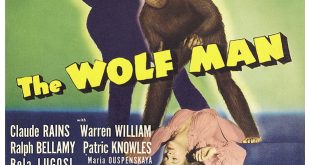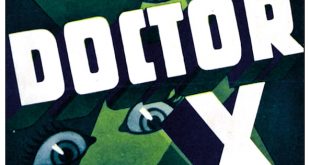 SYNOPSIS:
SYNOPSIS:
“Maximus, a small-time music hall mind reader, has frightening flashes of precognition; but he cannot predict or control them – until he realizes he has them in the presence of Christine, attractive daughter of a publisher, who makes Rene, his equally lovely wife, wretchedly jealous. But worse trouble comes to Maximus when he’s accused of causing a disaster he predicted.” (courtesy IMDB)
REVIEW:
I know what you’re thinking, there just aren’t enough great British horror films of the thirties concerning clairvoyants, right? Well, prepare to be enlightened, as the diminutive but very visible Claude Rains plays a con-artist clairvoyant who gains the power to actually predict the future, yet is unable to prevent it from happening. The Clairvoyant also happens to be the alternate title to this week’s atmospheric classic, The Evil Mind (1934) – but you knew I was going to say that, too. Don’t worry, I’m not going to carry on with the clairvoyance jokes, but of course you knew I was going to say that – I’m sorry, I just can’t seem to stop. Anyway, what drew audiences to The Evil Mind, a Gainsborough Picture, was its stars.
 Pop Quiz: Who is really the greatest Scream Queen of all time? Is it Barbara Steele or Ingrid Pitt, who starred in many classic horror movies of the sixties? Or could it be the lovely Elsa Lancaster who portrayed the ultimate female fantastic creation in The Bride of Frankenstein (1935), or screamers like Carolyn Munroe, Leanna Quigley or Sybil Danning? Who can claim so many horror projects in their busiest years? Well, all these women are worthy names to toss around, but for many the individual to remember for real Queen status remains a Canadian actress from Alberta named Fay Wray.
Pop Quiz: Who is really the greatest Scream Queen of all time? Is it Barbara Steele or Ingrid Pitt, who starred in many classic horror movies of the sixties? Or could it be the lovely Elsa Lancaster who portrayed the ultimate female fantastic creation in The Bride of Frankenstein (1935), or screamers like Carolyn Munroe, Leanna Quigley or Sybil Danning? Who can claim so many horror projects in their busiest years? Well, all these women are worthy names to toss around, but for many the individual to remember for real Queen status remains a Canadian actress from Alberta named Fay Wray.
 In 1933, Fay Wray was being threatened on movie screens by more than just King Kong (1933). Next in The Vampire Bat (1933) by, surprisingly enough, a bat, and then in The Mystery Of The Wax Museum (1933), threatened by…um, wax…and so on, as she faultlessly played hapless heroines in horrendous hazards. For the second and third time, she also had to endure Lionel Atwill’s formidable villainy. Consequently, the year 1933 was to be Fay’s busiest, as eleven different movies took to the screen with her name in the cast.
In 1933, Fay Wray was being threatened on movie screens by more than just King Kong (1933). Next in The Vampire Bat (1933) by, surprisingly enough, a bat, and then in The Mystery Of The Wax Museum (1933), threatened by…um, wax…and so on, as she faultlessly played hapless heroines in horrendous hazards. For the second and third time, she also had to endure Lionel Atwill’s formidable villainy. Consequently, the year 1933 was to be Fay’s busiest, as eleven different movies took to the screen with her name in the cast.
 Fay Wray sadly passed away in her Manhattan apartment in 2004 from natural causes, close to a month before celebrating her 97th birthday, and she was looking well. The immortal paramour of the apes, Fay Wray had been approached by director Peter Jackson about appearing in his remake of King Kong (2005), but declined with an unarguable finality. Some actors will go to extraordinary lengths to avoid working in New Zealand.
Fay Wray sadly passed away in her Manhattan apartment in 2004 from natural causes, close to a month before celebrating her 97th birthday, and she was looking well. The immortal paramour of the apes, Fay Wray had been approached by director Peter Jackson about appearing in his remake of King Kong (2005), but declined with an unarguable finality. Some actors will go to extraordinary lengths to avoid working in New Zealand.
 Claude Rains returned to his homeland after his recent success in Hollywood with The Invisible Man (1933). I’ve always enjoyed the great acting of Claude Rains, and found his over-acting most amusing. It wasn’t until after this film that Rains went on to become a great dramatic actor, appearing in Casablanca (1942) and many greater starring roles. Rains never needed cue cards, he always remembered his many long lines to perfection, something considered a remarkable feat in Hollywood of today. I’m not even going mention his zillions of early television appearances. No!
Claude Rains returned to his homeland after his recent success in Hollywood with The Invisible Man (1933). I’ve always enjoyed the great acting of Claude Rains, and found his over-acting most amusing. It wasn’t until after this film that Rains went on to become a great dramatic actor, appearing in Casablanca (1942) and many greater starring roles. Rains never needed cue cards, he always remembered his many long lines to perfection, something considered a remarkable feat in Hollywood of today. I’m not even going mention his zillions of early television appearances. No!
 Other pleasing appearances include a relatively unknown cast of now recognisable character actors including Donald Clathrop, Jack Raine and Frank Cellier. Ronald Shiner can be glimpsed during a crowd scene, D.J. Williams is a member of the jury and a fifteen-year-old Graham Moffatt appears as a page. Moffatt later found fame as a prominent stock company member of the Will Hay comedies as Albert. And of course Athole Stewart, who seemed to play nothing but lords, knights, squires, captains, colonels, governors. He seemed to be the ultimate authority figure of his time.
Other pleasing appearances include a relatively unknown cast of now recognisable character actors including Donald Clathrop, Jack Raine and Frank Cellier. Ronald Shiner can be glimpsed during a crowd scene, D.J. Williams is a member of the jury and a fifteen-year-old Graham Moffatt appears as a page. Moffatt later found fame as a prominent stock company member of the Will Hay comedies as Albert. And of course Athole Stewart, who seemed to play nothing but lords, knights, squires, captains, colonels, governors. He seemed to be the ultimate authority figure of his time.
The producer, Sir Michael Elias Balcon, was known for his work with Ealing Studios. When he was invited to head Ealing in 1938, he readily agreed. Under his benevolent leadership and surrounded by a reliable team of directors, writers, technicians and actors, Ealing became the most famous British studio in the world, despite turning out no more than six feature films a year. Quality over quantity seems to be a tradition. The great anthology film Dead Of Night (1945), Went The Day Well? (1942), and of course the Ealing comedies were released during his time there. In over 230 films he worked with Alfred Hitchcock, Basil Dearden, Michael Relph, me, and many other British greats of the film world. He was made a Knight Commander Of The Order Of The British Empire Of The Yada-Yada-Yada in 1948. After World War Two, his style of ‘nice’ films were on the way out, so Ealing Studios started going down the tubes during the fifties, and Balcon’s creative control at other companies waned considerably. The last film on which he worked as executive producer was Tom Jones (1963), after which he continued to encourage young directors, funding low-budget experimental work – in other words, pretentious rubbish.
 I shouldn’t really say that but, I mean, he is dead after all, and it’s not like any of those up-and-coming directors are ever going to give me a job, are they? Anyway, enough of my complaining (it’s not as if anyone listens, do they?). It’s not clairvoyance so much as, say, Deju Vu in reverse. No, wait. that would be Uv Ujed…Uvu Jed? Uh oh, I think I’ve invoked the name of an ancient one, and I think I’d like to leave before he gets here. So please join me next week when I have the opportunity to sterilise you with fear during another terror-filled excursion to the dark side of…Horror News! Toodles!
I shouldn’t really say that but, I mean, he is dead after all, and it’s not like any of those up-and-coming directors are ever going to give me a job, are they? Anyway, enough of my complaining (it’s not as if anyone listens, do they?). It’s not clairvoyance so much as, say, Deju Vu in reverse. No, wait. that would be Uv Ujed…Uvu Jed? Uh oh, I think I’ve invoked the name of an ancient one, and I think I’d like to leave before he gets here. So please join me next week when I have the opportunity to sterilise you with fear during another terror-filled excursion to the dark side of…Horror News! Toodles!
The Evil Mind (1934)
 Horror News | HNN Official Site | Horror Movies,Trailers, Reviews
Horror News | HNN Official Site | Horror Movies,Trailers, Reviews





